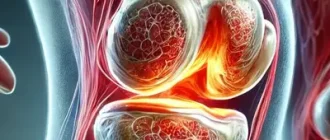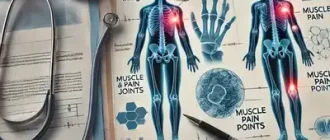Tearing the cartilage that separates the thighbone and the shinbone and stabilizes the kneecap is a common cause of knee pain and disability. Anyone, regardless of age or amount of physical activity, is at risk for this injury. However, due to the weakening and disintegration of the meniscal structure caused by the degradation of the cartilage, patients with knee arthritis are more likely to experience a spontaneous meniscal rupture.
Knee arthritis is a type of joint inflammation that affects one or all of the three knee compartments. This condition occurs when the cartilage becomes thinner or absent, causing the bones to rub together, leading to bone thickening and bony spurs. The inflammation can also strain the knee’s ligaments and cause chronic joint pain, stiffness, restricted range of motion, and difficulty exercising or moving in damp weather.
Causes
A meniscal tear is a common injury among people with arthritis, especially those who engage in activities that require sudden knee twisting movements, such as sports like soccer or basketball. However, degenerative tears can also occur in older adults with weakened meniscal structures. Worn tissue is more likely to tear, so a simple movement like getting up from a chair can result in a meniscal tear. The condition can worsen without treatment, and the loss of the meniscus can lead to wear-and-tear arthritis.
One of the major causes of knee osteoarthritis (OA) is meniscal tear. Several studies have shown that a meniscal tear can lead to knee OA, whereas knee OA can also lead to a spontaneous meniscal tear. Asymptomatic meniscal tears are common and are frequent incidental findings on knee MR imaging of the middle-aged or older patient. A degenerative meniscal lesion in the middle-aged or older patient could suggest an early stage of knee OA. Medical professionals may recommend surgery for large tears, but this may increase a person’s risk of developing arthritis. Lifestyle changes, regular exercise, balance training, and weight management may also help manage OA.
Athletes and people with arthritis can take steps to prevent knee injuries and knee meniscal tears. Guidelines published in 2017 note that incorporating jumping, running, and balance exercises into warm-up sessions can prevent knee injuries. Exercises like lunges and squats can help strengthen the knee joint and make it more resistant to injury. It is essential to discuss treatment options with a doctor to find a solution that allows an individual to return to regular activities. Recovery from surgery to repair a torn meniscus can take anywhere from 3 to 6 months, depending on the type of surgery they underwent.
Diagnosis
A knee meniscus tear can be challenging to diagnose in someone with arthritis. A physical examination by a doctor is typically the first step in identifying a meniscus tear. During the examination, the doctor might ask the patient to squat, walk, and move their leg into different positions to assess any signs and symptoms of the tear. They may also use imaging tests, such as an MRI, to confirm the diagnosis.
Arthritis and a meniscus tear can share some similar symptoms, such as pain and swelling around the knee joint. However, arthritis pain tends to develop gradually over time, while a meniscus tear often causes sudden, sharp pain after an injury. Additionally, the quality of the pain may differ, with arthritis pain often described as a dull, aching sensation, while meniscus tear pain is typically sharp and immediate.
To confirm a meniscus tear diagnosis, healthcare professionals may use the Thessaly test, a simple diagnostic exam that can be conducted by the patient while standing and twisting on one foot. Catching or locking sensations during this exam can indicate a meniscus tear. With proper diagnosis, treatments such as strengthening exercises, manual therapy, and surgical removal of damaged tissue may help improve pain and function.
Treatment for the Torn Meniscus of the Knee Joint in Arthritis
Arthritis and a torn meniscus in the knee may be treated with a number of different methods. The first step in treating a tear is getting a proper diagnosis from your doctor, which will depend on the severity, location, and size of the injury. This manual will give a high-level overview of the available therapeutic options.
Conservative Treatment:
If your tear is not too severe, your doctor may recommend taking it easy. Don’t put stress on the injured knee by walking or running. Using a cold pack for 20 minutes many times a day may also help reduce swelling and pain. Knee pain may sometimes be alleviated with over-the-counter medications like acetaminophen or ibuprofen.
Physical Therapy:
Similarly useful is physical therapy. The surrounding muscles and the knee joint itself may benefit from this. In the long run, this may make your knee feel more stable and less painful. Be careful to do the exercises prescribed by your physical therapist, as they are tailored to your individual needs.
Surgery:
Surgery may be needed if non-invasive procedures fail to repair your tear. A meniscectomy or meniscal repair may be suggested by your surgeon, depending on the severity and location of the tear. When a meniscal tear occurs, a meniscectomy is performed to remove the injured tissue, whereas a meniscal repair includes sewing the torn tissue back together.
Recovery
The length of time it takes to recover following surgery will depend on the kind and extent of your disease. Physical therapy is often recommended to aid in healing and strengthen the patient. If you want a quicker and easier recovery, it’s important to strictly adhere to your surgeon’s instructions.
Prevention
A meniscus tear may be caused by an accident or your genes, but you can reduce your risk of getting one by exercising and stretching regularly. The knee may be made stronger and more resistant to damage by the use of exercises such as lunges and squats. In addition, you should stay away from any actions that might potentially injure your knee, such as excessive twisting or pivoting.
In Conclusion
When dealing with arthritis and a torn meniscus in the knee, there are a number of therapeutic options available. Rest, ice, and pain medication are all options for conservative care. Physical therapy may also be used to restore strength and stability to the knee. Surgery is sometimes required in life-threatening circumstances. Last but not least, the best defense against more damage or a worsening of symptoms is a good offense. Discuss your illness treatment options with your doctor and follow their advice for the best possible result.
About the Author
Reyus Mammadli is the author of this health blog since 2008. With a background in medical and biotechnical devices, he has over 15 years of experience working with medical literature and expert guidelines from WHO, CDC, Mayo Clinic, and others. His goal is to present clear, accurate health information for everyday readers — not as a substitute for medical advice.







